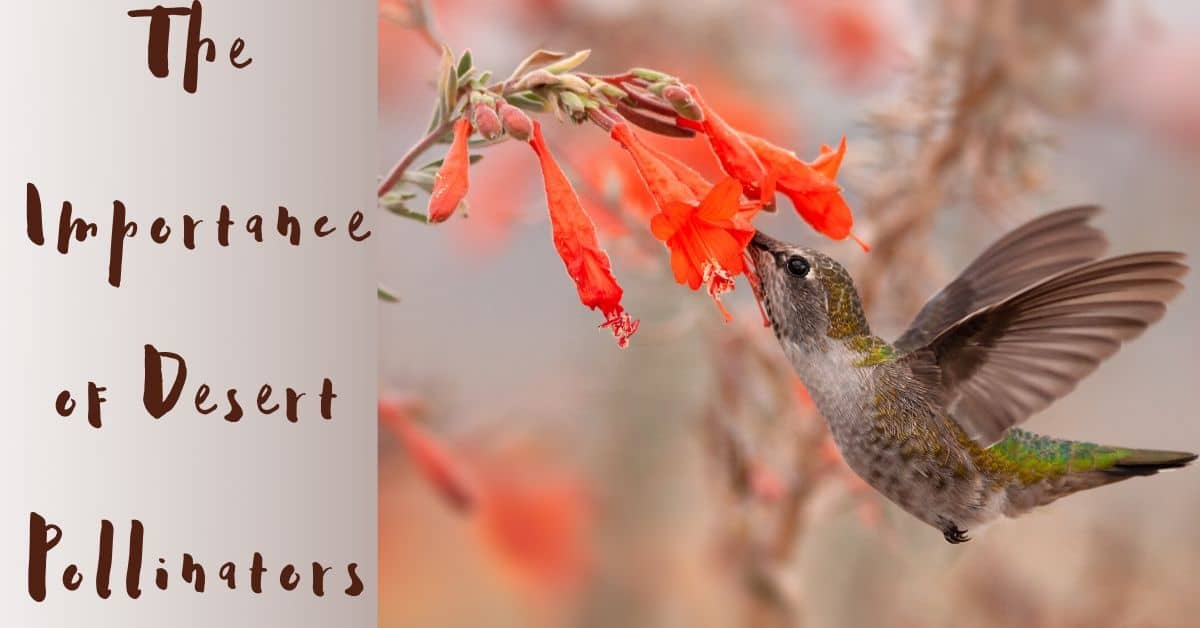- Finding the Right Indoor Plants for Desert Your Home - April 28, 2023
- Common Misunderstanding About Sun Exposure - April 18, 2023
- All about the Arizona Monsoon Season - May 21, 2021
Your day-to-day life in Central Arizona probably involves our local tangle of highways and interstate freeways which wrap Phoenix and its surrounding region in busy human traffic. While we get our bearings on these highways, it may surprise many of us to learn that the land we live on is also part of another kind of super highway – one we may not even notice if we aren’t paying attention. Central Arizona is a key spot for many species of migrating pollinators who play a critical role in maintaining the health of the desert ecosystem.
Desert Pollinators
Hummingbirds, bats, butterflies, bees and even doves help pollinate the plants of the desert. Without these helpful animals and insects, many iconic desert species, like the towering saguaro cactus cannot produce fertile seeds that continue the genetic diversity and distribution of new plants. Pollinators are often “keystone” species in an ecosystem, meaning that many other parts of the biome rely on their behavior to succeed. Some pollinators are generalists, serving many different species of plants while others perform a highly specialized role in the ecosystem.
Regardless of their habits, most desert pollinators are facing declining populations due to human-based factors. When humans change the environment we often remove or replace specific native species pollinators have adapted to. Planting exotic non-native plants or invasives in a region can interfere with native plant populations, sometimes pushing them out entirely. We also disrupt large swaths of once-wilderness, turning former swaths of native plants into a disconnected patchwork. Human-manufactured chemicals such as insecticide and fungicide can also indiscriminately injure or kill pollinator species.
Migratory Pathways
Central Arizona and the Sonoran Desert are a major hub for various species of migratory pollinators, many of which make an annual trek from the southern west coast of Mexico up a so-called “nectar corridor” that extends through Arizona and the western mountain ranges, even reaching up into Canada for some species.
Migratory pollinators have adapted to regional plants over many millennia to make their lifetime of travel viable. For species like the Monarch butterfly, an annual migration involves several generations while en route. Monarchs can make use of a wide variety of regional milkweeds to sustain them wherever they land. While Monarchs have adapted to many different types of milkweed, humans entirely clearing milkweed from an area can wreak havoc on the complex migration of these butterflies.
Pollinators and Timing
Pollinators, especially those who migrate, have to perform a precisely timed dance so that they leave their origin point at the right time to reach various food sources along their route. This is one of the many systems that climate change has endangered. With the blooming patterns of plants thrown into disarray with irregular weather patterns, pollinators are finding themselves arriving too early or too late at a location to feed themselves and perform important pollinating work for the plants to fruit.
Lesser long nosed bats make a migration based on the blooming of cactus and agave plants. They require large, dense areas of plants to sustain themselves on nectar as they migrate. When excessive drought or heat or irregular weather interfere with the plants’ cycles, bats and blooms may miss each other, causing the populations of both to decline – bats through starvation and scarce food and plants through a reduced amount of viable seed.
In the Mojave Desert, the pollination of the region’s signature Joshua trees are dependent on yucca moths which emerge in the spring synchronized with the flowering of the tree. However, this synchronicity is falling out of step with climate change. Joshua trees have been provoked by unpredictable climate events to bloom too early or too late to intersect with the emergence of the moths.
Start At Home
Living on a nectar corridor means there’s a lot of work to do to help support pollination relationships. At home, it encourages us to plant native species that are needed by pollinators to sustain themselves. Attracting pollinators benefits humans too. Not only do we get to enjoy the company of hummingbirds, or hear the buzz of native bees, we’re encouraging a wider environmental restoration where localized pockets can help repair some of the damage already done to these critical components of desert ecology.
With a native garden outside your house, who wouldn’t want to spend more time outdoors? As the summer months approach, consider our patio screens for a comfortable time outside. Contact us today to learn more!

